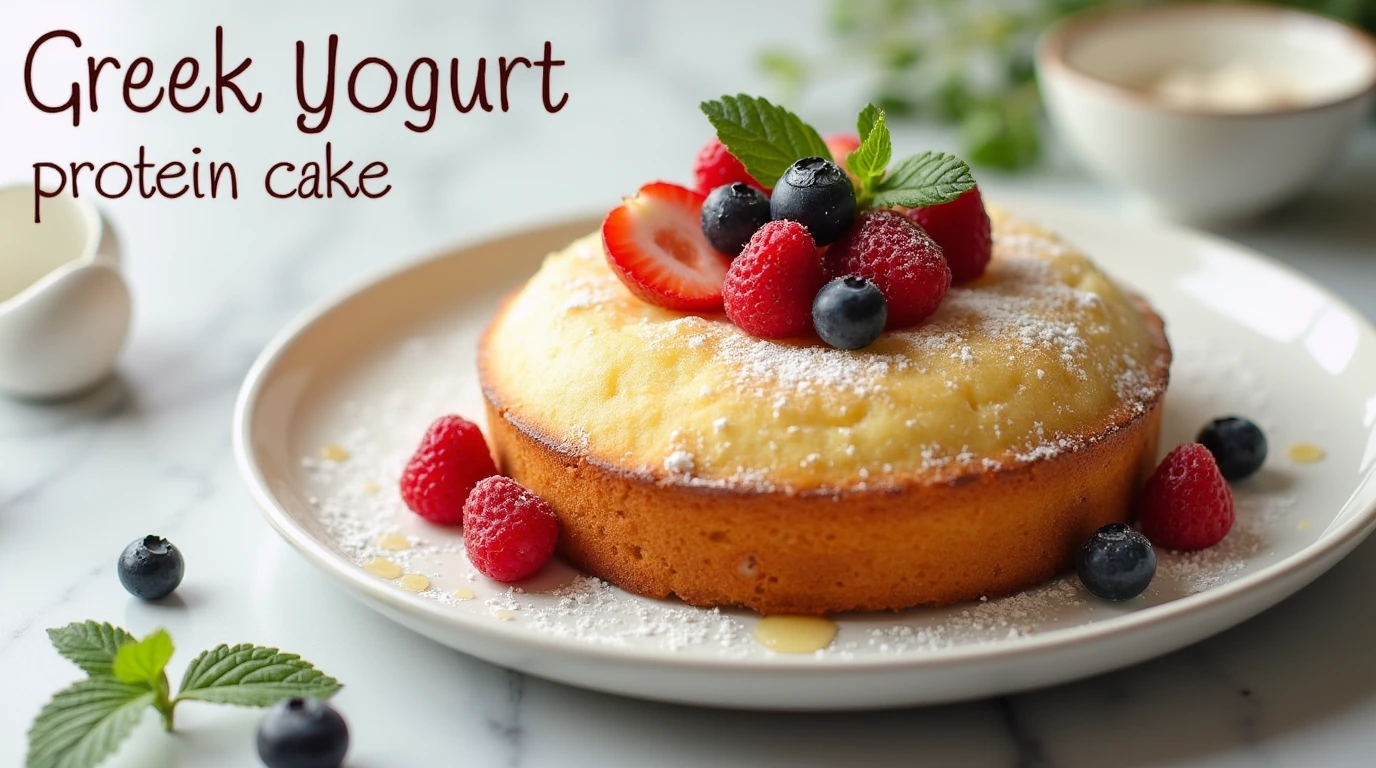When it comes to indulging in desserts, finding a balance between taste, texture, and nutritional value is key. Enter the Greek Yogurt Protein Cake—a delicious, healthier alternative to traditional cakes that satisfies your sweet tooth without compromising on your fitness goals. Packed with protein from Greek yogurt and a lighter approach to calorie content, this protein cake is perfect for anyone looking for a low calorie high protein treat that’s both nutritious and delicious.
In this article, we’ll explore how to make the Greek yogurt cake, discuss the health benefits of using Greek yogurt in baking, and share ideas on how to incorporate this cake into your diet as a protein dessert. Whether you’re trying to eat low carb low calorie, experimenting with protein baking, or simply looking for a healthy yogurt cake, this recipe is sure to become a staple in your kitchen.
Why Choose a Greek Yogurt Protein Cake?
Making protein desserts doesn’t have to mean sacrificing flavor, and with Greek yogurt, you can achieve a cake that’s not only tasty but also packed with health benefits. Here’s why the Greek yogurt protein cake is a great choice:
- High in Protein: Greek yogurt is rich in protein, which helps with muscle repair and growth, making it an ideal choice for anyone following a high protein low cal diet. Protein is also great for keeping you feeling fuller for longer, helping to curb cravings and support weight management.
- Low in Calories: This cake is made with ingredients that are naturally lower in calories than traditional cake recipes. By using Greek yogurt and reducing sugar content, you can enjoy a slice of cake without feeling guilty about the calories.
- Low Carb, Low Calorie: For those following a low carb low calorie diet, Greek yogurt provides a creamy base with a good balance of healthy fats and protein, making it perfect for a low carb high protein dessert. You can also customize the ingredients to make the recipe even more suitable for your dietary needs.
- Rich in Probiotics: Greek yogurt is a good source of probiotics, which are beneficial bacteria that support gut health. By including Greek yogurt in your baking, you’re not only getting a delicious treat but also boosting your digestive health.
- Versatile and Customizable: The Greek yogurt protein cake can be adapted to suit your tastes or dietary preferences. You can add fruit, nuts, or even a bit of chocolate to make the cake your own. This makes it an excellent option for a variety of occasions, from healthy snacks to birthday treats.
- Great for Protein Baking: If you’re interested in protein baking, this recipe is a great starting point. By replacing traditional cake ingredients with healthier alternatives, such as Greek yogurt and protein powder, you can bake delicious cakes that also support your fitness goals.

Ingredients for Greek Yogurt Protein Cake
To make the Greek Yogurt Protein Cake, you’ll need ingredients that are packed with protein, healthy fats, and low-calorie content. Here’s a simple list of what you’ll need to bake this cake:
For the Cake:
- 1 cup Greek yogurt (preferably full-fat or low-fat, depending on your preference)
- 1 cup oat flour (or almond flour for a lower carb option)
- 2 large eggs
- 1/4 cup protein powder (whey protein or plant-based protein powder)
- 1/2 teaspoon baking powder
- 1/4 teaspoon baking soda
- 1/4 teaspoon salt
- 1 teaspoon vanilla extract
- 2 tablespoons honey (or a sweetener of your choice, like stevia or monk fruit)
- 1/4 cup unsweetened almond milk (or regular milk if preferred)
For the Frosting (optional):
- 1/2 cup Greek yogurt
- 1-2 tablespoons honey (or your preferred sweetener)
- 1/2 teaspoon vanilla extract
- 1 tablespoon protein powder (for an added protein boost)
How to Make Greek Yogurt Protein Cake
Now that you have your ingredients ready, let’s walk through the steps to create your Greek yogurt protein cake. This cake is simple to make, and with just a few basic steps, you’ll have a delicious and nutritious treat ready to enjoy.

Step 1: Prepare the Dry Ingredients
Start by preheating your oven to 350°F (175°C). Prepare a round cake pan by greasing it lightly with cooking spray or lining it with parchment paper for easy removal.
In a large bowl, combine the oat flour, protein powder, baking powder, baking soda, and salt. Whisk everything together to ensure that the dry ingredients are well incorporated. This mixture will form the base of the cake and provide structure and texture.
Step 2: Mix the Wet Ingredients
In a separate bowl, whisk together the Greek yogurt, eggs, vanilla extract, and honey. The Greek yogurt will provide moisture and richness to the cake, while the eggs help bind the ingredients together. The honey adds a touch of sweetness, but feel free to adjust the sweetness to your preference.
Next, add the unsweetened almond milk (or regular milk) to the wet ingredients. The almond milk helps thin out the batter and contributes to the cake’s light texture.
Step 3: Combine Wet and Dry Ingredients
Slowly pour the wet ingredients into the dry ingredients and stir until just combined. Be careful not to overmix, as this can result in a dense cake. The batter should be thick, but pourable.
Step 4: Bake the Cake
Pour the batter into the prepared cake pan and smooth the top with a spatula. Place the pan in the preheated oven and bake for 20-25 minutes, or until a toothpick inserted into the center comes out clean. The cake should be golden brown on top and firm to the touch.
Once the cake is done baking, remove it from the oven and allow it to cool in the pan for 10 minutes. After that, transfer the cake to a wire rack to cool completely.
Step 5: Prepare the Frosting (Optional)
While the cake is cooling, you can prepare the frosting. In a bowl, mix together the Greek yogurt, honey, vanilla extract, and protein powder. Whisk everything until smooth and creamy. The protein powder helps thicken the frosting and adds a protein boost. If you prefer a thicker frosting, you can add more protein powder or adjust the amount of honey to your liking.
Step 6: Frost the Cake
Once the cake has cooled, spread the frosting evenly over the top. You can decorate it with fresh fruit, nuts, or even a drizzle of dark chocolate if desired. For an added protein boost, sprinkle some extra protein powder over the top.
Serving Suggestions for Greek Yogurt Protein Cake
This Greek yogurt cake is versatile and can be served in a variety of ways depending on the occasion. Here are some ideas for how to enjoy this protein-packed treat:
- Post-Workout Snack: After a workout, treat yourself to a slice of protein cake to help replenish glycogen stores and support muscle recovery. The high protein content will help rebuild muscle tissue while satisfying your sweet tooth.
- Healthy Dessert: Serve Greek yogurt protein cake as a healthy dessert after dinner. It’s a great alternative to traditional high-calorie cakes and is a perfect way to enjoy a guilt-free treat.
- Meal Prep: If you’re prepping meals for the week, this cake can be cut into slices and stored in an airtight container in the fridge. It makes an easy and satisfying snack or dessert throughout the week.
- Special Occasions: This cake can also be a great choice for birthdays, celebrations, or any occasion where you want to offer a healthier dessert option. The cake’s protein-packed nature ensures you can indulge without going overboard on sugar or empty calories.

Health Benefits of Greek Yogurt Protein Cake
This cake isn’t just delicious—it’s packed with health benefits, making it a great addition to a balanced diet. Here are a few key reasons why the Greek yogurt protein cake is a great choice for your next snack or dessert:
- High in Protein: Protein is essential for muscle repair and growth, and the addition of Greek yogurt and protein powder in this cake provides a substantial amount of protein. This makes it an excellent post-workout snack or a healthy dessert for anyone trying to increase their protein intake.
- Supports Digestion: Greek yogurt contains probiotics, which are beneficial bacteria that help promote a healthy gut microbiome. This can support digestion and overall gut health.
- Low in Calories: Unlike traditional cakes made with butter and refined sugar, this recipe uses Greek yogurt, honey, and protein powder to keep the calorie content low without sacrificing flavor. This makes it a great option for those following a low-calorie high-protein diet.
- Rich in Fiber: Oat flour, which is used in this cake, is high in fiber, which aids in digestion and helps maintain stable blood sugar levels. Fiber is also known to promote feelings of fullness, which can be helpful for those trying to manage their weight.
- Gluten-Free Option: By using oat flour instead of regular wheat flour, this recipe can be made gluten-free, making it suitable for those with gluten sensitivities or celiac disease.
Variations and Customizations for Greek Yogurt Protein Cake
While the base recipe is delicious on its own, you can customize the protein cake to suit your preferences or dietary needs. Here are some variations to try:
- Add Fruit: Add fresh or dried fruit, such as blueberries, strawberries, or bananas, to the cake batter for extra sweetness and flavor. Fruit also adds natural vitamins and antioxidants.
- Nutty Protein Cake: Add chopped nuts such as almonds, walnuts, or pecans to the cake for added crunch and a boost of healthy fats.
- Chocolate Protein Cake: Mix in some cocoa powder or chocolate chips for a chocolatey version of the protein cake. You can also use dark chocolate for a healthier twist.
- Vegan Option: For a vegan version, use plant-based protein powder, almond milk, and flax eggs (1 tablespoon ground flaxseed mixed with 3 tablespoons water) instead of regular eggs.
- Spices: Add a teaspoon of cinnamon or nutmeg to the batter for a spiced version of the cake, perfect for fall or when you want to change things up.
Conclusion: A Healthy and Delicious Protein-Packed Dessert
The Greek yogurt protein cake is the ultimate solution for anyone looking to enjoy a healthy dessert without compromising on flavor. Packed with protein, low in calories, and easy to make, it’s the perfect treat for any occasion—whether it’s a post-workout snack, a birthday celebration, or a guilt-free indulgence after dinner. The versatility of this cake allows you to customize it to suit your tastes, making it an excellent option for protein baking and a great way to stay on track with your high protein low cal diet.
So, next time you’re craving something sweet, consider whipping up this healthy yogurt cake and enjoy a nutritious, satisfying treat that you can feel good about eating. With just a few simple ingredients and a little creativity, you’ll have a protein dessert that’s both delicious and good for you!


